Emma CROUCH (1832-1904)
Emma Crouch was born in 1832 in London, England the youngest daughter of Edmund and Matilda Crouch. Her father died while she was still a young girl and her older brothers George and Charles left England for Australia arriving in Portland around 1838. Her sister Matilda married and moved to the United States of America in 1849. Emma continued to live with her mother and they resided at Roxeth, in the parish of Harrow on the Hill in London. By the 1861 England Census, Emma and her mother were living still at Roxeth with Emma was working as a governess. Her mother died two years later.
In 1865, Emma’s sister Matilda died in California, and her children, Arthur McCann aged twenty, Kate McCann aged sixteen, and Eustasia de Arroyave aged eight, travelled to England to live with Emma in Roxeth. The following year, Emma then aged thirty-four along with her nephew and nieces, boarded Great Britain (below) for Melbourne arriving on Boxing Day, 1866.

“GREAT BRITAIN”. Image courtesy of the State Library of Victoria http://handle.slv.vic.gov.au/10381/95167
They then caught the steamer S.S. Edina (below left) to Portland to join Emma’s brother George and Charles.

SS EDINA NEAR WARRNAMBOOL c1863. Image courtesy of the State Library of Victoria http://handle.slv.vic.gov.au/10381/28324
The brothers had established themselves in Portland. Both were in business and George was one of Portland’s first councillors. The Trangmar brothers James and Charles were their business partners at times and George and Charles each married a Trangmar sister.
Once settled in Portland, Emma started a school in Hurd Street.

Advertising (1876, July 11). Portland Guardian, p. 2 (EVENINGS.). http://nla.gov.au/nla.news-article63316814
She was also an active member of the St. Stephen’s Anglican Church (below).

ST STEPHEN’S ANGLICAN CHURCH, PORTLAND. Image courtesy of the State Library of Victoria http://handle.slv.vic.gov.au/10381/4157628
The Crouch family connection with the Trangmar family continued in 1876 when Emma’s niece Kate married James William Trangmar, a son of James Trangmar Sr. They moved to Coleraine where the Trangmar family operated a store. In the following years, Emma and Eustasia also moved to Coleraine, around the time James took over full operations of the store. I like to think Emma and her nieces may be in the photo below, possibly in the garden of the adjoining house.

J.W TRANGMAR’S STORE, COLERAINE c1890. Image courtesy of the Museums Victoria Collections https://collections.museumsvictoria.com.au/items/767465
Emma also established a school for young ladies in Coleraine beginning in 1881.

Advertising (1880, December 16). Hamilton Spectator, p. 4. http://nla.gov.au/nla.news-article225488162
She kept busy in the Coleraine community. She was a member of the Coleraine Glee Club with Kate and Eustasia. The glee club opened the evening entertainment at the Coleraine Presbyterian Concert in 1881, thought to be the best concert held in Coleraine. Also on the bill that night, was Alfred D’Orsay Tennyson Dickens, a son of author Charles Dickens. Alfred was living in Hamilton then and dropped in to read one of his father’s works.

COLERAINE c1909 Image courtesy of the State Library of Victoria http://handle.slv.vic.gov.au/10381/385977
Emma was an active member of the Holy Trinity Anglican Church congregation and ran the local Girls Friendly Society connected to the church. The first Coleraine Industrial Exhibition was held in 1887 and Emma was on the executive committee. For the 1890 exhibition, the walls of the hall were adorned with artworks by local ladies including Emma. At the 1894 exhibition, Emma won first prize with her tortoiseshell cat. She also entered potted plants and cut flowers into shows run by the Coleraine Horticulture Society.
Portland was still close to Emma and she often holidayed there. In 1904, however, Emma fell sick after her return to Coleraine from a summer holiday in Portland. To convalesce, she travelled with Eustasia to Kate’s home in Sturt Street, Ballarat but she died on 11 April 1904. She had remained close to her nieces during their thirty-eight years in Victoria and it was fitting Emma spent her last days with them.
The Portland Guardian reported Emma’s remains arrived by the evening train, then were “resting the night before the altar at St Stephen’s” ahead of the funeral service. The funeral cortege left the church for her burial at the Portland Cemetery.
A memorial service was also held at Coleraine after her death and, on 20 December 1904, a stained glass window was dedicated to the memory of Emma at the Holy Trinity Church, Coleraine (below). It was made by Mr. Montgomery of Melbourne and it depicted the Good Shepherd with the words “To the glory of God and loving memory of Emma Crouch, born Oct. 8, 1832, at rest April 11, 1904”

HOLY TRINITY CHURCH, COLERAINE 1970. Image courtesy of the J.T. Collins Collection, La Trobe Picture Collection, State Library of Victoria http://handle.slv.vic.gov.au/10381/216987
DRISCOLL Mary (c1828-1908) also known as Mary O’DRISCOLL and Mary WADMORE
Mary O’Driscoll was born in Middlesex, England around 1828. At the age of twenty, she married James Wadmore and they started a family. On 8 November 1854, the couple and baby Mary boarded the Constant at Southhampton with their destination being Portland Bay. James acted as an assistant to the ship’s surgeon on the voyage which saw an outbreak of whooping cough.

Local Intelligence. (1855, February 26). Portland Guardian and Normanby General Advertiser, p. 2 (EVENING). http://nla.gov.au/nla.news-article71571784
The Constant arrived at Portland Bay on 22 February 1855. Mary was carried ashore by one of the crew.

PORTLAND BAY c1857. Image courtesy of the State Library of Victoria http://handle.slv.vic.gov.au/10381/266998
James secured work with Charlton Hedditch at Cape Bridgwater, twenty kilometres or so further west. It was an isolated area on the coast, a far cry from Westminster, London. It was there in 1855, a daughter Anne was born. In 1856, James was able to select land at Cape Bridgewater, close to what is now Blowholes Road, in partnership with George Terril. A son William was born the following year and a daughter Sarah in 1859.
A month after Sarah’s birth, James was fishing on the rocks on the west coast of Cape Bridgewater with his mates George Terrill and Robert Wilson.

CAPE BRIDGEWATER c1880. Image courtesy of the State Library of Victoria http://handle.slv.vic.gov.au/10381/335580
The sea was rough and the men decided to move from their position as it was becoming dangerous. They set up in a new spot but about ten minutes later James returned to where they were first located. A large wave came up and washed him from the rocks. George and Robert saw him swimming but he soon tired and sank. His body was found washed up on the rocks the following Thursday and an inquest was conducted. Mary’s account was forwarded to Portland’s Police Magistrate and subsequently to the Portland Guardian and Normanby General Advertiser.

FATAL ACCIDENT AT BRIDGEWATER (1859, October 31). Portland Guardian and Normanby General Advertiser, p. 3 (EVENINGS.). http://nla.gov.au/nla.news-article64512566

CAPE BRIDGEWATER. Image courtesy of the State Library of Victoria http://handle.slv.vic.gov.au/10381/64458
That left city girl Mary with a farm and four young children, including a newborn to raise alone. However, with the help of the other women in the district, she soon learned all she needed to run her farm and raise her children in the harsh and often lonely environment she found herself in.
Mary’s care extended beyond her own family. She was known for riding a “spirited bay mare” across the district helping those who were sick. In doing so, she was familiar with the ailments of the local residents. In 1873, Mary was called as a witness at the inquest into the death of young Joshua Black who was found dead in his bed one Monday morning in May. Mary was one of the last people to see Josuha alive on the previous evening, and she was able to say he appeared well and in no pain. With her knowledge of Josuha’s medical history, she was also able to offer the evidence that Josuha’s health at times was fragile and he had previously had a bad cough and some pain above his heart but had been well since the last winter. Margaret’s witness statement is part of the inquest file of Josuha Black held by the Public Record Office of Victoria and available online. In her statement, her opening sentence was, “I am a labouring woman living at Cape Bridgewater”.
When Mary’s daughter Sarah was fifteen, around 1874, the local state school teachers approached Mary with an offer to train Sarah as a teacher. Mary was very proud of Sarah who went on to become the headteacher at Kentbruck six years later. Mary remained at Cape Bridgewater until around 1905. By then, Sarah was the headteacher at Tahara State School and her sister Anne was living with her and keeping the house. Sarah retired from her position and she and Anne moved to Portland. It was planned Mary would move from Bridgewater to live with them. She sold her various farm implements.

Advertising (1905, June 16). Portland Guardian, p. 2 (EVENING). http://nla.gov.au/nla.news-article63692584
Sarah and Ann purchased, Annesley in Julia Street, Portland, to operate as a private guest house.
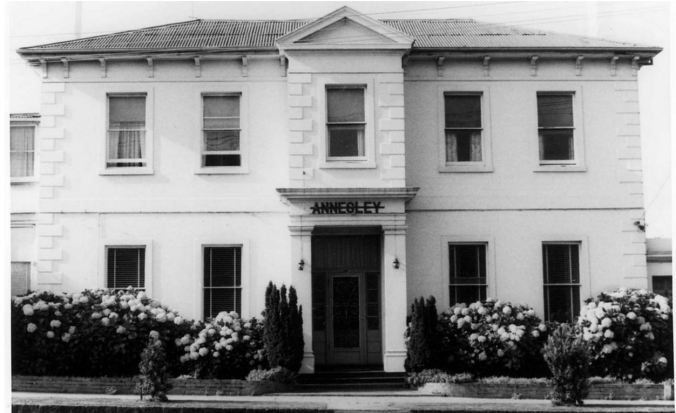
“ANNESLEY”, PORTLAND Image courtesy of the J.T. Collins Collection, La Trobe Picture Collection, State Library of Victoria. http://handle.slv.vic.gov.au/10381/233404
The girls looked after her mother until her death at Annesley on 3 March 1908. Sarah and Anne continued on in Portland with Sarah contributing to the Book of remembrance of the pioneer women of the Portland Bay district in 1934, in which Mary’s story was told. Sarah Wadmore died in 1941 and her sister Ann in 1942.
Margaret BROWN: (1835-1939) also known as Margaret WALKER
“As quietly as she had lived for 104 years, Mrs. Thomas Walker, Hamilton’s grand old lady, passed away at her home in Shakespeare Street on Thursday last.” (Portland Guardian, 23 October 1939)
And so began the obituary of Margaret Walker (nee Brown). After fourteen years of the newspapers documenting some of Margaret’s significant birthdays, 90, 99, 100, 101, 103, and 104, they were saying their last farewell to a woman who lived during the reign of six British monarchs.
Margaret was born in Launceston on 11 August 1835 to Scottish immigrants John and Margaret Brown. They had arrived in Launceston in the early 1830s. They headed to Victoria around 1840 on the City of Sydney and John Brown was employed at Customs House in Portland. On 11 August 1852, Margaret’s seventeenth birthday, she married Thomas Walker, a twenty-nine-year-old Londoner who had arrived in Portland in the early 1840s. They were married by Presbyterian minister Reverand Ross at Portland.
The couple settled in Portland and remained there until 1866, when they moved to Hamilton, residing in Lonsdale Street. Thomas made his living as a land agent and was able to acquire land around the town. Margaret and Thomas had eight children. Two died as babies and in September 1880, her eldest son John Thomas died aged twenty-one. Then in July 1900, their son Frederick was accidentally killed at Subiaco, Western Australia.
Close to 1909, Margaret and Thomas went to live at 5 Shakespeare Street, Hamilton and that is where Thomas died in April 1909 at the age of eighty-six. By that time, Mary had one remaining son, George who lived in Geelong, and two daughters, Eliza in Melbourne and Maria who lived with Margaret.
When Margaret was ninety-seven, Maria died on 1 July 1932 at Hamilton at the age of seventy-six. The following year was Margaret’s ninety-eighth birthday and she was given a walking stick. By the time her ninety-ninth birthday came around in 1934, she hadn’t used the walking stick. She also didn’t wear glasses and would spend a few hours in her garden each day. By that time she also had nine grandchildren and nine great-grandchildren.
Also in 1934, was the centenary of white settlement in Victoria, and an event was planned for Portland on 19 November. Margaret booked her accommodation well in advance. Her name would appear in the Book of remembrance of the pioneer women of the Portland Bay district written to coincide with the celebrations. She was one of only thirty-five female settlers named in the book still alive for the centenary. On the day, she was seated in a special area for those who had lived in Portland prior to 1864.

PORTLAND CENTENARY CELEBRATIONS 1934. Image courtesy of the Museums Victoria Collections https://collections.museumsvictoria.com.au/items/766444
Margaret expected to be presented to the Duke of Gloucester but organisers overlooked that detail on the day. Word got back to the Royal party and a letter was forwarded to Margaret. She received it from His Royal Highness through his equerry (Captain Schrieber) in December 1934. It read:
The Royal train, Queensland, December 3rd, 1934.
Dear Madam, the Duke of Gloucester is sorry to hear that, owing to an oversight, you were not presented to him when His Royal Highness visited Portland, and he wishes me to congratulate you on attaining the age ninety-nine years, and hopes that you will continue in good health to see your centenary. You will be glad to know that His Royal Highness enjoyed his visit to Portland very much.
It was a busy year. Margaret planted a commemorative tree at the western end of Gray street, Hamilton for the centenary celebrations, and she produced seventeen pieces of eyelet linen work, made to give as gifts to family and friends.
In 1935, Margaret’s 100th birthday celebration was held at the Hollywood Cafe in Hamilton with the Mayor of Hamilton, Cr. Stewart, in attendance. The Hollywood Cafe can be seen on the extreme left in the photo below. The enclosed verandah displayed the name of the cafe, and it shared the ground-level verandah with the boot and shoe store.

GRAY STREET, HAMILTON. Image courtesy of the State Library of Victoria http://handle.slv.vic.gov.au/10381/62977
After that outing, it became difficult for Margaret to get out on her birthday, so the Mayor of the day would visit her at her home instead. For her 101st birthday in 1936, twenty-five friends and family gathered at Margaret’s home in Shakespeare Street. Highlights were a birthday cake with 101 candles and a telegram from the Red Cross Society. Sadly Margaret’s daughter Eliza died in November of that year.
The next three birthdays were celebrated quietly at home but Margaret continued in good health. That was until only weeks after her 104th birthday. Margaret became fragile, eventually passing away on Thursday 19 October. She was buried the following day at the Hamilton (Old) Cemetery with Thomas and Marion.
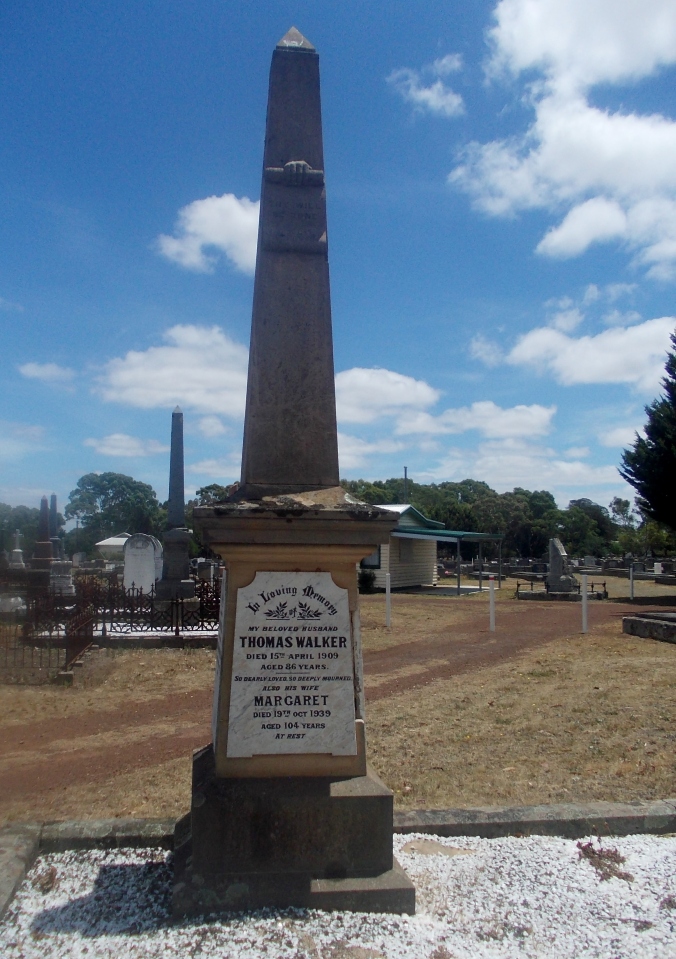
GRAVE OF THOMAS AND MARGARET WALKER AND THEIR DAUGHTER MARION WATSON. HAMILTON (OLD) CEMETERY. Image courtesy of the State Library of Victoria
Her obituary read:
During the whole of her sometimes eventful life, Mrs. Walker was a lover of all things beautiful, and in quiet contentment, surrounded by her own people and home where she could indulge her liking, which amounted to almost passion, for her garden, she enjoyed to the full her heart’s desire. (Portland Guardian 23 October 1939)
The remaining living member of Margaret’s immediate family at the time of her death was her son George Joseph Walker. He died in 1960 at Geelong.
REID, Isabella (c1873 -1953) Also Known as Isabella Gilhome
Isabella Reid was the daughter of William Reid and Johanna Steven and was born near Heywood in 1874, one of thirteen children. The Reid farm was Athol Hill on the Fitzroy River two miles from Heywood. In August 1917, Isabella then aged thirty-four, married Charles Gilhome of Colac at the Heywood Presbyterian Church. The reception was held at Heywood’s Federal Coffee Palace on the corner of Edgar and Scott Streets and owned by her father.

Portland Guardian (1917, August 17) p. 2 (EVENING). http://nla.gov.au/nla.news-article64019248
Isabella and Charles at first lived at Heywood but moved to Bundoora in early 1918. It was then a rural area and Charles ran a dairy farm. Around the same time, Charles began feeling unwell and was diagnosed with a liver condition. That led to depression and in July 1918, his doctor told him he should go away for a while. Charles and Isabella discussed his plight and Charles decided he would go away for a break. But it was too late. He died on Friday 12 July 1918.
Isabella initially stayed in the Bundoora area but returned to Heywood to be with her aging parents. In 1921, her father William died and in December 1922, the property in his estate was put up for sale including Athol Hill and the coffee palace. Isabella went on to purchase the coffee palace and adjoining land from the sale.

Advertising (1922, December 23). Weekly Times, p. 18. http://nla.gov.au/nla.news-article224001699
Vanda Savill’s book Dear Friends, Heywood (1976) mentions Isabella Gilhome and her sister Eliza Reid ran the coffee palace owned by the Reid family. It’s hard to establish when that was. A newspaper article from the Portland Guardian in 1914 mentions Miss Reid as the hostess, however that could have been her sister Eliza.

Heywood Jottings. (1914, April 29). Portland Guardian, p. 3 (EVENING). http://nla.gov.au/nla.news-article63968838
Isabella didn’t hold ownership of the coffee palace for long because, in September 1924, it and the adjoining shop was purchased by Edwin Bond.
In May 1925, Isabella’s mother Johanna died aged eighty-three. After her death, Isabella purchased Retreat in Millbanke Street, Portland, and she and her sister Eliza left Heywood.

News in Brief (1925, October 26). Portland Guardian, p. 3 http://nla.gov.au/nla.news-article64108579
On 8 July 1927, a furniture sale on Isabella’s behalf was held at Retreat with the property already sold.

Advertising (1927, June 30). Portland Guardian, p. 2 (EVENING). http://nla.gov.au/nla.news-article64257690
Isabella again returned to Heywood. As a widowed woman, it was necessary for Isabella to generate an income and she was able to do that with property investment. Later her obituary would read,
After the death of her husband, Mrs. Gilhome took part in many business transactions, becoming well known as a keen businesswoman through the purchase and sale of houses and shops. She was one of the first to recognise the growing land values in a period of rapid development.
In May 1929, Isabella bought a block of land and house in Heywood from the estate of Patrick King with frontages to Edgar and Lindsay Streets.

Advertising (1929, April 24). Portland Guardian, p. 2 (EVENING). http://nla.gov.au/nla.news-article64269205
In 1932, she applied to purchase Crown Land adjoining Scott, Edgar, and Lindsay Streets. While in 1945, she applied to subdivide allotments 4 and 5 of section 7 in Lindsay Street. In 1946, the Portland Shire Council bought a house belonging to Isabella at Heywood for £1300 for use as an engineer’s residence.
Isabella’s activities in Heywood and Portland went beyond business. She was a generous and charitable woman and gave back to the community. In 1927, she donated a blackwood armchair to the Portland Hospital and another chair for the women’s ward at the hospital.

PORTLAND HOSPITAL c1945. Image courtesy of the State Library of Victoria http://handle.slv.vic.gov.au/10381/366378
During WW2, Isabella was active with the Heywood Red Cross and was on the committee of the Heywood Returned Soldiers Association Women’s Auxilary She donated money and knitted balaclavas and socks towards the war effort.
William and Johanna Reid were among the earliest parishioners at St Andrew’s Presbyterian Church in Heywood and by 1939, their daughter Isabella was the oldest parishioner. In April 1939, she was given the honour of turning the key at the official opening of St Andrew’s Sunday School. Her connection to St Andrew’s extended to the Heywood Presbyterian Ladies Guild.
Isabella Gilhome died in July 1953 at Heywood aged eighty. She was buried at the Heywood Cemetery.
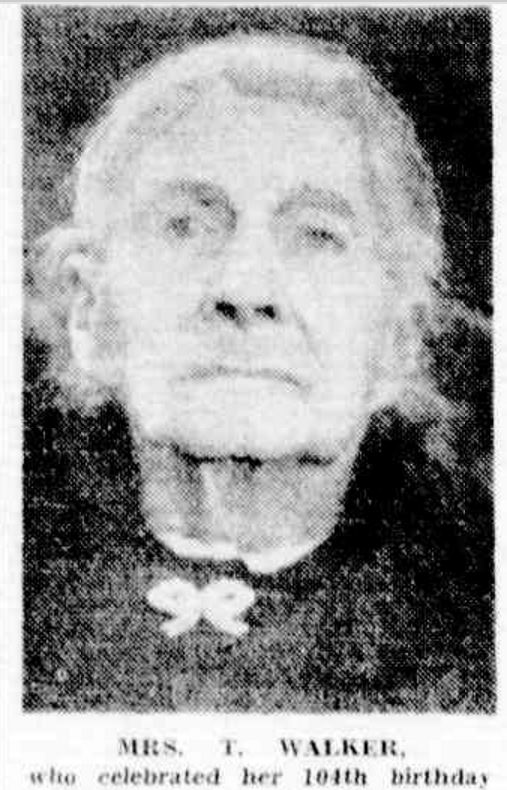

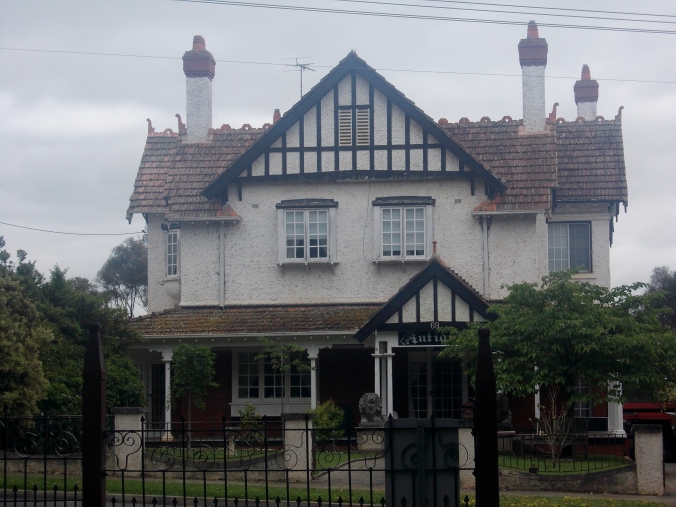
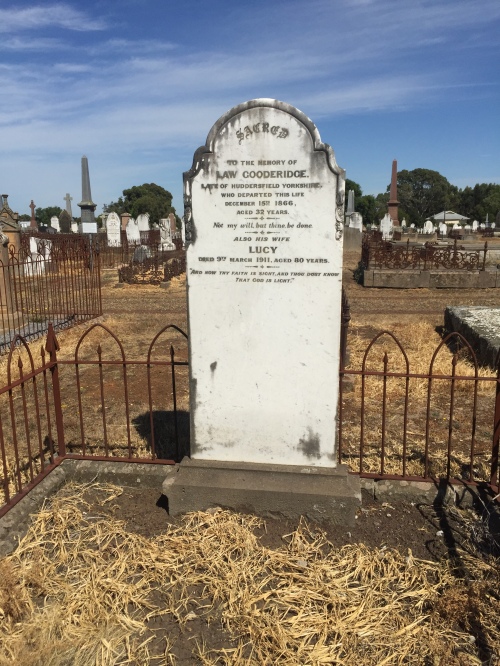

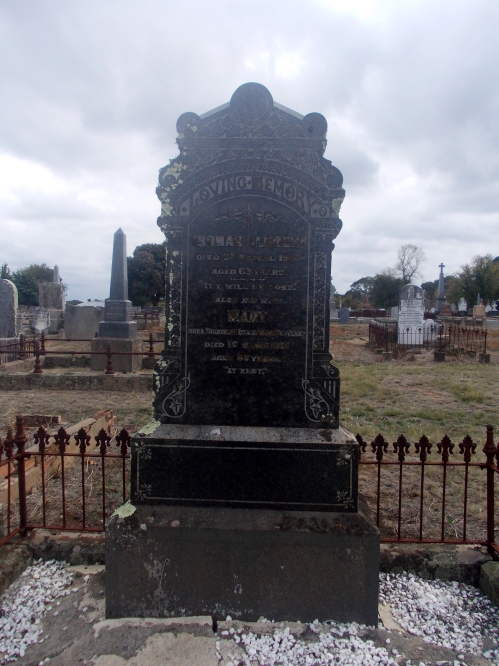
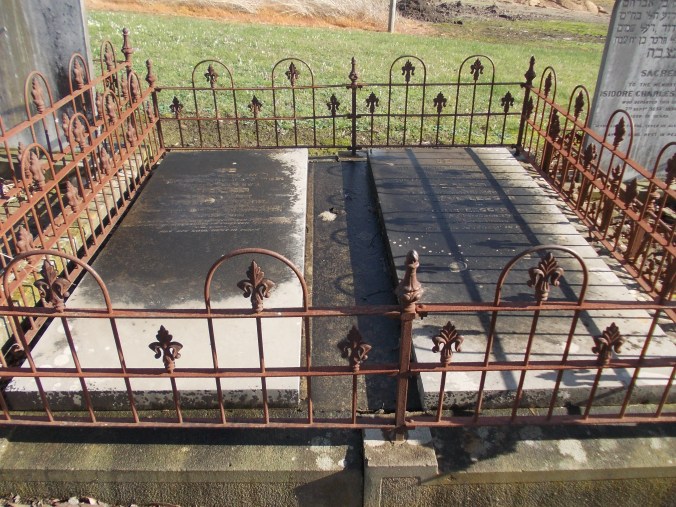
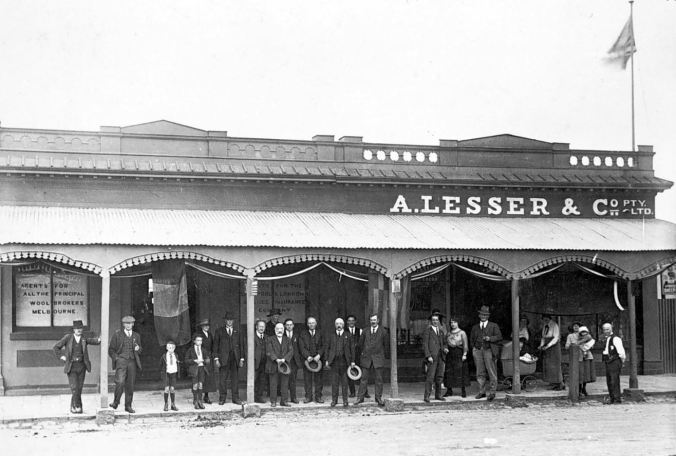
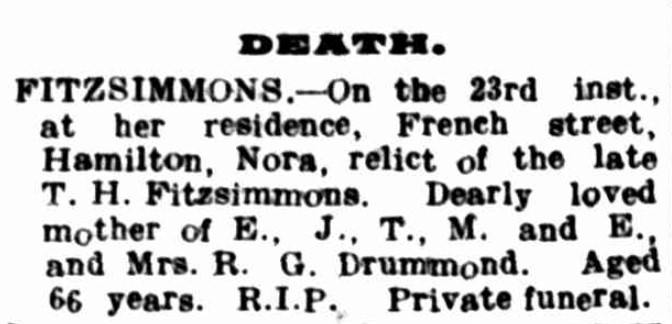
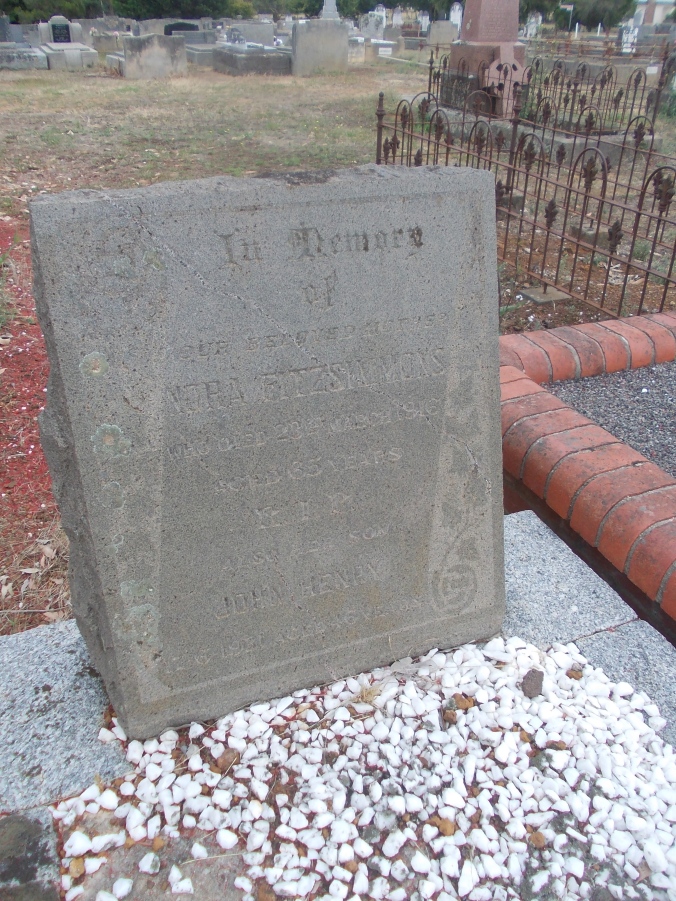


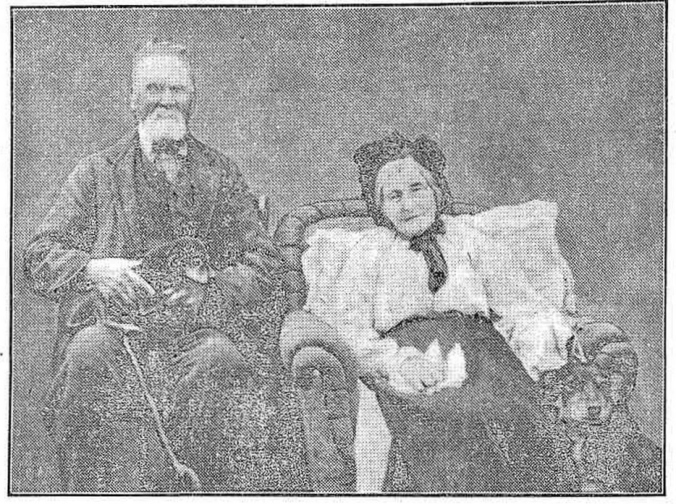
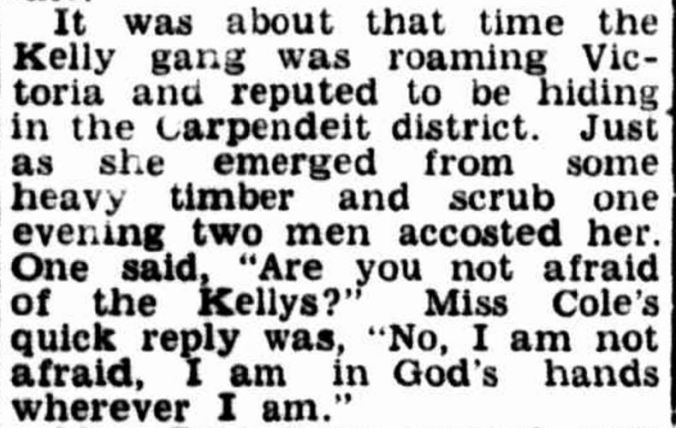
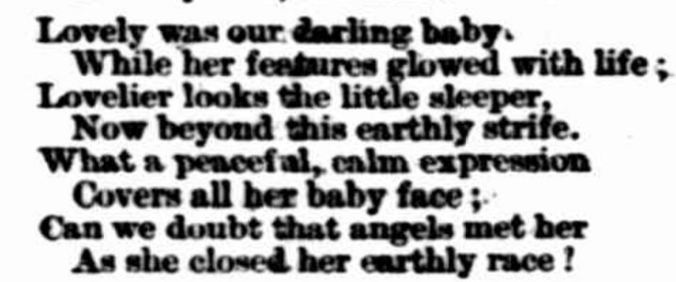
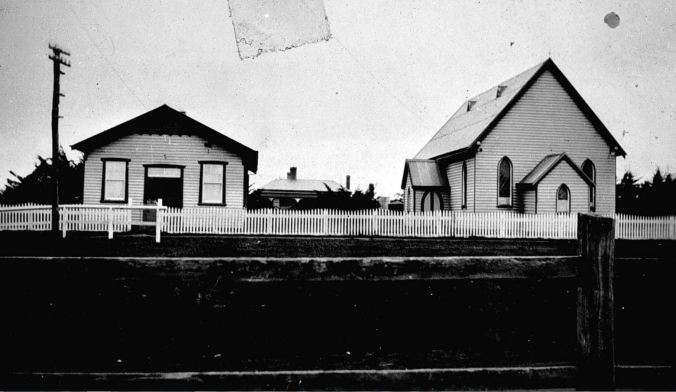
You must be logged in to post a comment.